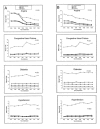Disparities in trends of hospitalization for potentially preventable chronic conditions among African Americans during the 1990s: implications and benchmarks
- PMID: 12604494
- PMCID: PMC1447762
- DOI: 10.2105/ajph.93.3.447
Disparities in trends of hospitalization for potentially preventable chronic conditions among African Americans during the 1990s: implications and benchmarks
Erratum in
- Am J Public Health. 2003 May;93(5):703
Abstract
Objectives: We compared trends in prevalence rates of preventable cardiovascular- and diabetes-related hospitalizations between African Americans and members of other major US racial/ethnic groups.
Methods: Standardized rates for 1991 to 1998 were derived from hospital and US census data for California.
Results: African Americans had significantly higher hospitalization rates in 1991, and discrepancies in rates continued to widen through 1998. Overall male and female rates were approximately 3 times higher for angina, 7 times higher for hypertension, between 7 and 8 times higher for congestive heart failure, and 10 times higher for diabetes.
Conclusions: Widening disparities in cardiovascular- and diabetes-related health conditions were observed in this study, possibly owing to racial inequalities in provision of effective primary care.
Figures

References
-
- Cooper R. Health and social status of US blacks. Ann Epidemiol. 1993;3:137–144. - PubMed
-
- Ford R, Cooper RS. Implications of race/ethnicity for health and health care use. Health Serv Res. 1995;301:237–252.
-
- Quality First: Better Health Care for All Americans. Washington, DC: President’s Advisory Commission on Consumer Protection and Quality in the Health Care Industry; 1998.
-
- Healthy People 2010. Washington, DC: US Dept of Health and Human Services; 2000.
Publication types
MeSH terms
LinkOut - more resources
Full Text Sources
Medical

